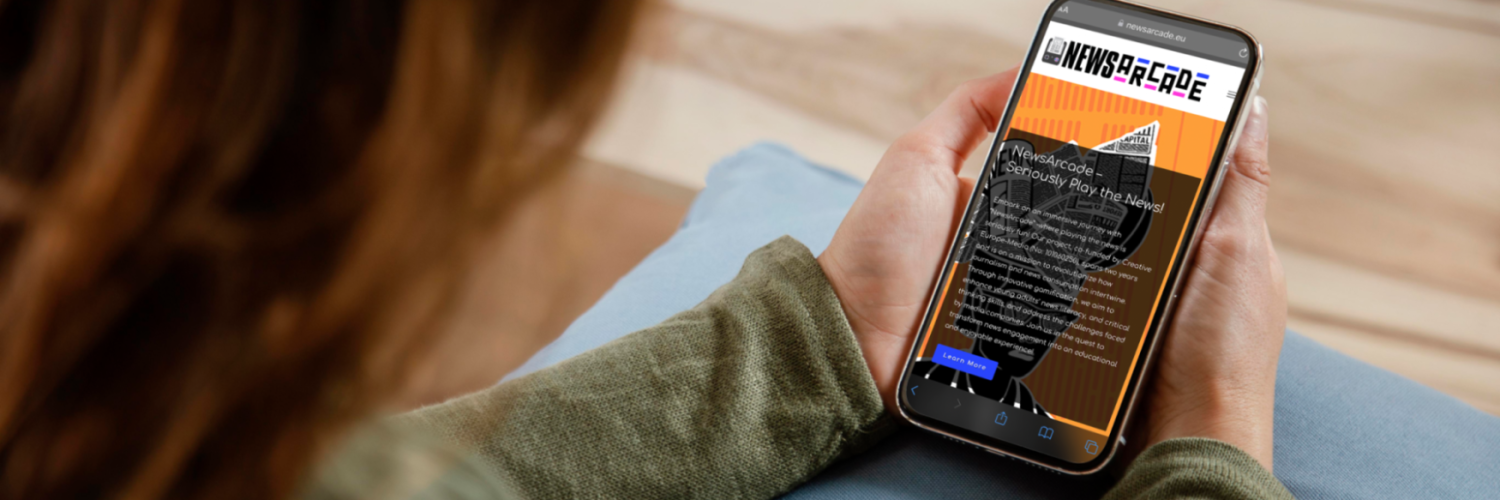by Fionnuala Joyce; Julia Conemans and Anne Bothmer, The Netherlands Institute for Sound and Vision.
Media channels are facing a significant challenge. Due to the rise of disinformation, threats to democracy, skepticism of science, and ongoing criticism of journalists, their legitimacy is increasingly being undermined. In the current climate, distrust of the media continues to grow. To establish a healthy relationship with the media, young adults must develop skills to engage with the news critically.
NewsArcade is a European project aimed at addressing this challenge by combining journalism with gamification. By developing a tool that uses real news content in an interactive format, the project seeks to increase young adults’ engagement with the news and strengthen the position of media channels. However, at this stage it is still being explored what its educational value can be for increasing media literacy.
How does it work?
The NewsArcade tool takes users through the various choices made during the journalistic creation process, challenging them to craft a news article from a series of options prepared for them by journalists. The journalist sets the goal to strive for a certain news value, such as making the piece ‘impactful’ or ‘analytical’, and the user gains points for aligning the story with the news value of the challenge. By engaging young adults with this process and helping them to understand how news is made, the tool aims to enhance media literacy and critical thinking. The project seeks to create a fun and comprehensive approach to news storytelling, hereby fostering a better engagement with media.
Who is involved?
Co-funded by Creative Europe-Media, the project’s consortium consists of DIAS Publishing House, Portaplay, Sud Ouest, WAN-IFRA (World Association of Newspapers and News Publishers), L’Association de la presse d’information générale, The Netherlands Institute for Sound and Vision, University of Southern Denmark (SDU) & IN2.
Scale-ups
Once a first version of the tool was developed, Sound & Vision and SDU investigated how the NewsArcade tool could be scaled up to other sectors and markets beyond publishing. We tested and gathered feedback about the tool with four groups: higher education professionals, journalism students, museum professionals, and librarians. These professionals were asked to evaluate the experience of using the tool, hereby assessing its potential value for their sector.
The scale-up sessions revealed that within the wide target group of young adults, the tool could cater to journalism students in the early stages of their education. As the news creators of the future, the tool could allow them to try out composing articles from different perspectives, thereby studying journalistic principles and news values in action. The librarians and museum professionals proposed that the tool could also potentially be used in upper secondary education.
Furthermore, in a scale-up event held by SDU during the World News Media Congress in Denmark, the tool proved to be a good conversation starter for journalists in training about making journalistic choices. SDU presented NewsArcade as part of a workshop on news values (as part of the Global Youth News Lab), during which 70 journalism students defined news values for Gen Z using the tool as a starting point. The workshop was documented in the following video:
Next steps
Following the scale-ups, it was found that more feedback and input was needed from young adults, journalists, and media literacy experts to improve the educational value of the tool and to further tailor it to the target audience’s preferences.
Currently, Sound & Vision is organizing an online focus group of international media literacy experts in June to explore areas for implementing NewsArcade. This includes looking at possible scenarios and settings in which the improved tool can be used, possible alignment with initiatives media literacy experts are involved in, as well as what accompanying resources are needed to enhance its educational value.
Get involved!
We believe this tool which offers publishers a new way of engaging with their audiences, and their audiences a way to be empowered as active news consumers, has great potential to serve as a tool for educators.
Would you like to explore this potential and get involved with our upcoming online media literacy focus group? Don’t hesitate to reach out to fjoyce@beeldengeluid.nl.
Authors
Fionnuala Joyce, Project Assistant (Research & Heritage), The Netherlands Institute for Sound & Vision.
Julia Conemans, Programme Manager (Research & Heritage), The Netherlands Institute for Sound and Vision.
Anne Bothmer, Project Assistant (Research & Heritage), The Netherlands Institute for Sound and Vision.














